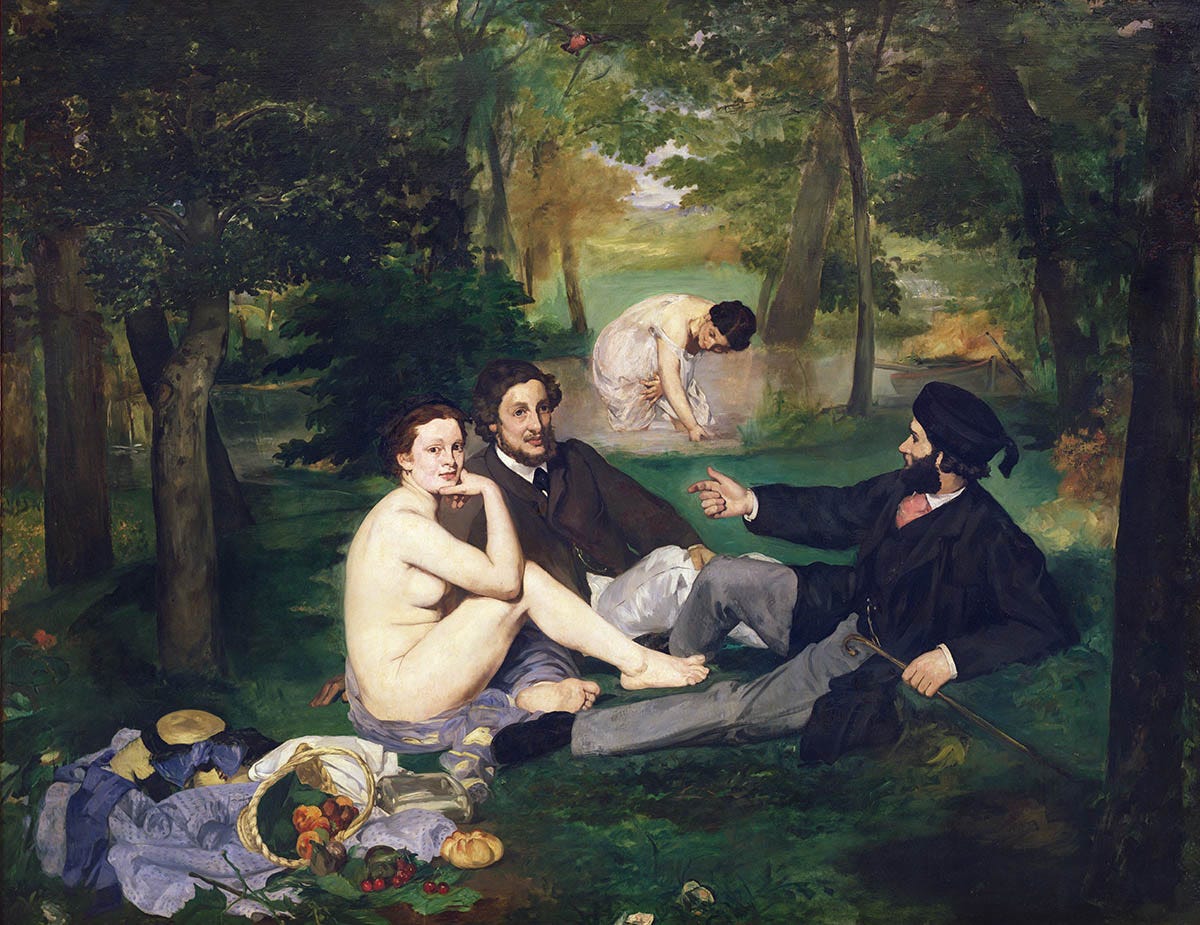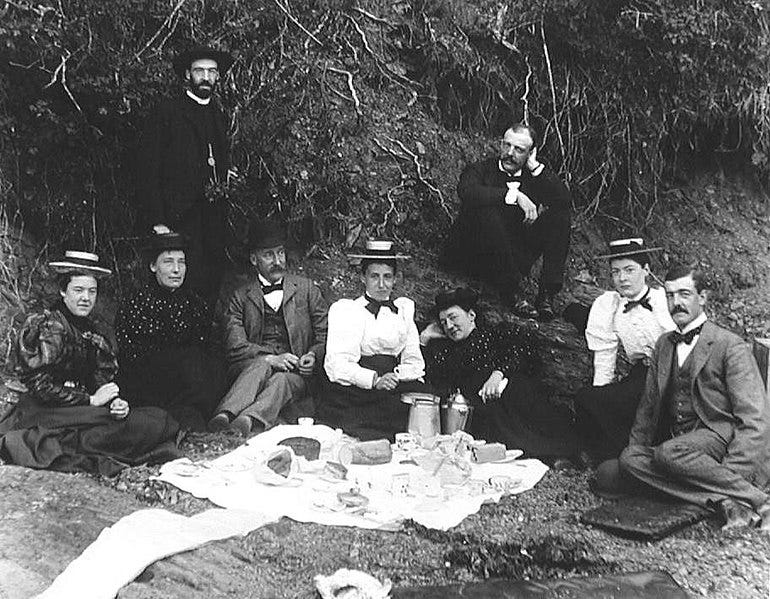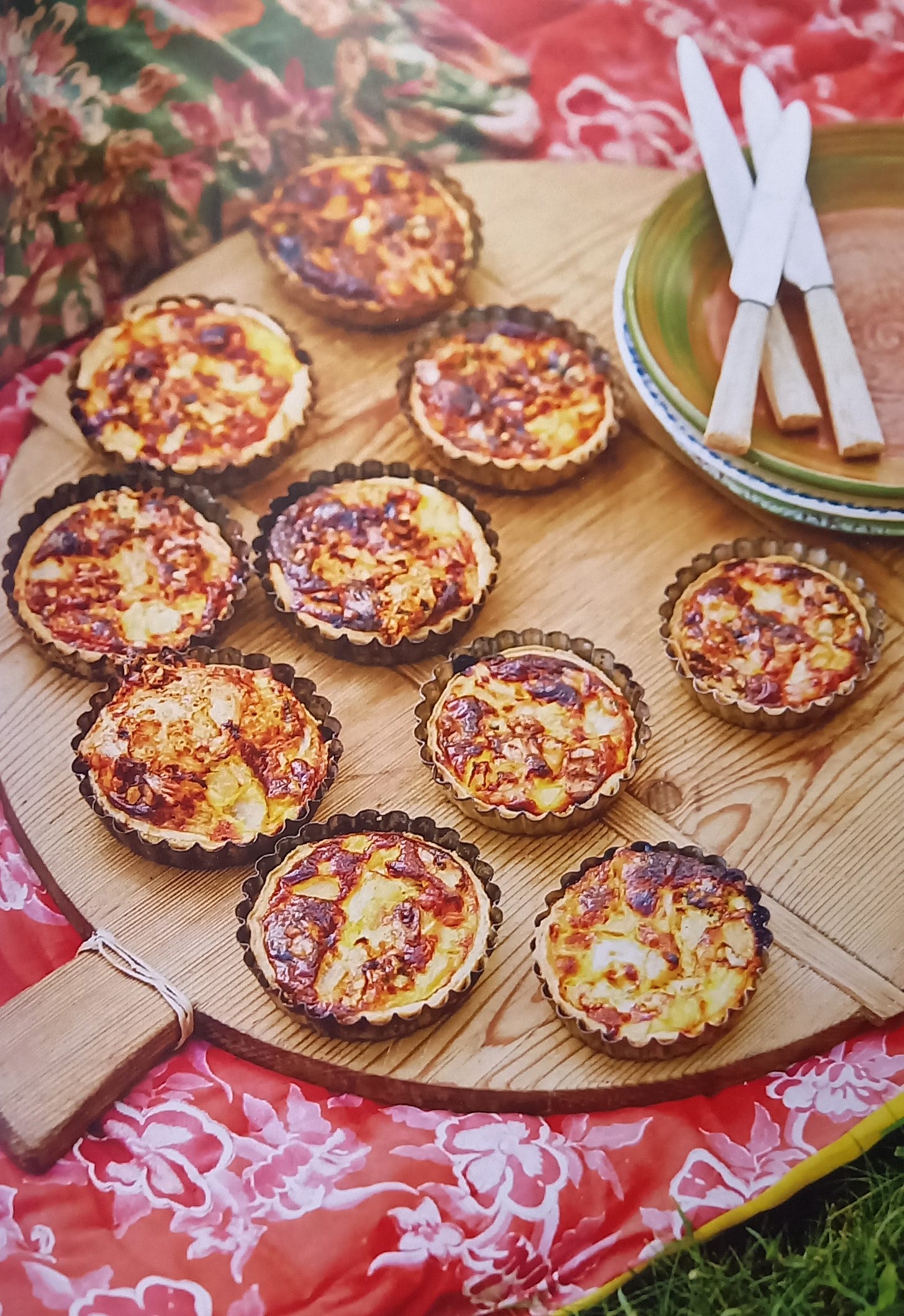As soon as we were judged mature enough to appreciate holidays abroad, my parents plucked my sister and me from the boarding houses and beaches of Cornwall and whisked us away to the Costa Brava. We would drive there through France and the Pyrenees, stopping for picnic lunches on the way. These were not simple events, although the food was simplicity itself - quickly and droolingly chosen at some French traiteur. It was the location of the picnic that presented the challenge.
A bucolic vista off a main road was not enough. My father also required a river and a train puffing by. This meant that, finally abandoning our search for perfection, our baguette, céleri rémoulade, carottes râpées, charcuterie, cheese and peaches were usually devoured shortly before we checked into some hotel for the night - in its car park. I think in all the years of our youth, we only found our father’s Utopia once.
Eating al fresco had long existed amongst nobles in Britain and Europe who went hunting for pleasure and required sustenance between stalking the stags. But it’s the French, in the 17th century, who are thought to be behind the invention of the pique-nique as entertainment. Sensibly, from a British weather perspective, they were held indoors. Fêtes champêtres, elaborate, formal and much larger pastoral festivals, were those held outdoors.
The difference between a pique-nique and a regular dinner party or luncheon was that guests were expected to bring a plate of food and some wine, or contribute to the overall cost. As such, they might more accurately be considered the precursor of the ‘pot luck’ gathering. When the French nobility fled the Revolution to London, they brought the pique nique with them, no longer flush enough to celebrate with their more formal and expensive ways of dining.
The word may have come from piquer, to peck or pick, and the noun nique, a small amount or even nothing at all. (But it may not. TooMuchInformation alert: Pique-Nique first appears in Les Charmans effects des barricades, ou l’amité durable de la compagnie des freres Bachiques de Pique-Nique. A burlesque satire of 1649, this snappy title translates as The Lasting Friendship of the Band of Brothers of the Bacchic Picnic. The main character, ‘Pique-Nique’, is a hero of the barricades during the Fronde, a series of French civil wars between 1648 and 1653. He is also a glutton, his greed a regrettable provocation given the food shortages are caused by the rebellion he is leading. “Boff”, as the French might say with a dismissive shrug.)
The Pic Nic Society was formed in London in 1801 by the refugees of the Revolution, to organise events that were far from refined. Hiring rooms for the purpose, members were required to bring a plate of food and six bottles of wine per head. Gatherings, which included a theatrical entertainment, were reported by The Times to be, not surprisingly, extravagant and raucous.
The English, historically suckers for the ways of the French - up until 23 June 2016*, at least - adopted the picnic more modestly. In 1808, Dorothy Wordsworth wrote to a friend that she had “picnicked” in the company of eighteen others on Grasmere Island in the Lake District. In 1816, Jane Austen included a rustic picnic on Box Hill, Surrey, in ‘Emma’. The Victorians considered them a genteel and suitable way for families and their children to connect with Nature and God, playing games, story-telling and singing once the meal was over. By the beginning of the 20th century, the increased availability of trains, bicycles and cars in the UK and the USA made a picnic outing to a park or the countryside an option for all social classes.
Mrs Beeton’s Book of Household Management, the housekeeping bible of every middle class Victorian ‘Mistress’, housekeeper, and cook, first published in 1861, is filled with lavish picnic menus. She proposed the following as a suitable portable repast: a joint of cold roast beef, a joint of cold boiled beef, two ribs of lamb, two shoulders of lamb, four roast fowls, two roast ducks, one ham, one tongue, fresh veal and pigeon pies, sandwiches of salad, meat or cheese, cheesecake, steamed puddings, jam puffs, fruit turnovers, ginger beer and ale, soda water and lemonade. A far cry from the grit in the sandwiches of my Cornish youth, eaten on wind-swept Polzeath beach wrapped in a permanently damp and sand-ingrained towel.
The French of today still seem to approach picnics more formally than other nations. I’ve never seen a French family picnic-ing on a rug on the ground. They set up folding tables and chairs and even Primus stoves, creating al fresco kitchens for a meal as formal as they would eat at home. If you consider just how many times during a blanket-based picnic you switch your folded, fizzing legs from left to right and back again, perhaps we should copy the French in this, too.
But picnics weren’t always civilised events. People took picnics on day trips to watch the Battle of Waterloo, nibbling delicately on chicken legs (Beef Wellington only invented once it was won) as soldiers were slaughtered on the plain below.
To observe the Battle of Bull Run on July 21, 1861, civilians who expected this first major battle of the American Civil War to be over swiftly, travelled, with their children and armed with hampers, 30 miles from Washington DC to Manassas in Virginia, to witness the exciting spectacle.
The journey would probably have taken them seven hours in their carriages, so those hampers would have been necessary to staunch their hunger, rather than to entertain.
Not all of those present were crass gawkers. There would have been politicians, there to observe, and journalists, there to report. Nevertheless, a Union captain, John Tidball, later wrote that he noted a “throng of sightseers” near his position. He described a crowd of men eager to watch the battle, along with a number of enterprising women who brought along “pies and other edibles” to sell to the spectators. “It was Sunday and everybody seemed to have taken a general holiday; that is, all the male population.”
*The date of the Brexit referendum result
Distanced from a traiteur, my mother’s idea of a picnic was a thermos flask with a hot sausage each stuffed down its throat. This recipe is more promising and has summer applications beyond picnics. I was thinking how much I liked the salad combination of blue cheese, pear and walnuts on a bed of mâche (lamb’s lettuce) or some other salad. Passé? Not if you turn it into tartlets…
4 tablespoons unsalted butter at room temperature
100g/3½ oz flour
2-3 tablespoons chilled water
300g/10 oz mild blue cheese such as Fourme d’Ambert or Bleu d’Auvergne, broken into 1¼ cm/½ in lumps
small fistful of walnuts, roughly chopped
4 pears, peeled, cored and slivered
1 egg, beaten
6 tablespoons whole milk
salt and freshly ground black pepper to taste
Preheat the oven to 200C/400F.
Make the pastry by adding the butter to the flour and rubbing it in briskly with your fingertips until the mixture resembles find breadcrumbs. Stir in enough cold water to make a firm but not sticky dough. Wrap it in parchment paper and chill for at least 30 minutes. Divide it into four pieces, roll them out to line four 10 cm/4 ins buttered tartlet tins. Fill them with pieces of cheese, walnut, and pear.
Beat together the egg and milk and season it. Pour this over the fillings and bake for 15-20 minutes, until the the tartlets are puffed and golden. Eat at room temperature or cold.







A Tabled reader emailed me this: Re the Manet, according to my Italian art history course, the Manet was a deliberate parody/challenge by him of two famous and revered Giorgione paintings (where the nude women and the clothed men were not seen as shocking by anybody, since they were 'classical'). His work can be seen as fully 'feminist'-aware in the terms of the time, between him and other revolutionary impressionists who were in so many ways challenging the assumptions and conventions of previous generations of artists and their society. The woman is a model and friend he often used (Victoire Meurent) - and also an artist member of the impressionists, and her direct gaze at us has been interpreted increasingly as both challenging and satirical, thus underlining his intention - think also of her direct gaze in the Olympia ('who you lookin at?!'. It was of course refused by the Paris Salon and so became one of the first in the Salon des Refusées.
A wonderful feast of a story, Julia! And being nostalgic... I remember that picnics in our family included some project. Usually a dam. While my grandmother unpacked the fried chicken and bread and butter sandwiches, my father and brother would be digging around and creating a dam in some nearby stream... me, mainly watching.